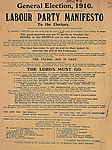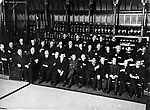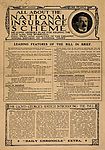 James Keir Hardie, founder of the Labour Party
James Keir Hardie, founder of the Labour Party Response to the Osborne Judgement 1908
Response to the Osborne Judgement 1908 Labour Party Manifesto 1910
Labour Party Manifesto 1910 Labour Party in Parliament 1911
Labour Party in Parliament 1911 National Insurance Scheme 1911
National Insurance Scheme 1911

The Labour Party grew out of the harsh working and living conditions of late 19th century Britain. Keir Hardie, one of Britain's most notable politicians and the first labour leader, believed that trade unions and the various socialist groups that existed at the time should join forces and create one large political party. Negotiations began, and in 1900 the Labour Representation Committee was formed. It became known as the Labour Party in 1906.
At first, trade unionists were not very supportive, but in 1901, the Taff Vale Judgement helped to change their minds. The Judgement ruled that unions could be sued for any damage caused by their actions. The trade union movement realised that if strike action was to remain one of its weapons in disputes, better representation in Parliament would be needed, and a working arrangement was agreed with the Labour Party for joint approval of Parliamentary candidates.
As trade union membership doubled, the Labour Party prospered. In a number of cases Labour MPs were able to influence legislation in favour of the unions and working people in general. The Trade Disputes Bill gave back to unions some of the legal immunity they lost under the Taff Vale Judgement. Miners' daily hours, working underground, were restricted to eight. Trades Boards were set up in 1909, which fixed minimum wages in some of the worst sweated industries in Britain. The women chainmakers of Cradley Heath were the first group of people to benefit. Labour MPs were also influential in the Liberal reforms which established labour exchanges, unemployment insurance and old age pensions. A major success came when, for the first time, MPs were paid a salary of £400 a year, making it easier for working men to stand for election.
The Great War saw a real breakthrough for Labour. The Osborne Judgement, which in 1908 had ruled it unlawful for trade unions to contribute to political funds, was reversed in 1913, so that when union membership increased by over 50%, the Labour Party saw a real increase in its finances. The urgent need to improve production brought some important improvements in working conditions and, for the first time, Labour MPs were able to gain experience of government in the coalition formed in 1915.
In 1918 all men over the age of 21, and women of property over the age of 30 were given the vote. Labour could now appeal to the masses. Of the 363 Labour candidates standing in the 1918 election 163 were sponsored by individual trade unions. 57 Labour MPs were elected. No less than 50 of them were trade union sponsored. The Black Country returned four Labour MPs, including Charles Sitch of Cradley Heath, sponsored by the Chainmakers' and Strikers' Association, who at the time was the secretary of the National Federation of Women Workers. By this time, the Labour Party had become the undisputed political voice of organised labour.
Rollover the captions in the box to see the available images in thumbnail format, click the caption to see the full-size image
| Reference: | 754 |
| Keywords: | |
| Archive Ref: | |
| Updated: | Wed 23 Apr 2008 - 1 |
| Interpretation written by | Barbara Harris |
| Author's organisation | |
| Organisation's website |